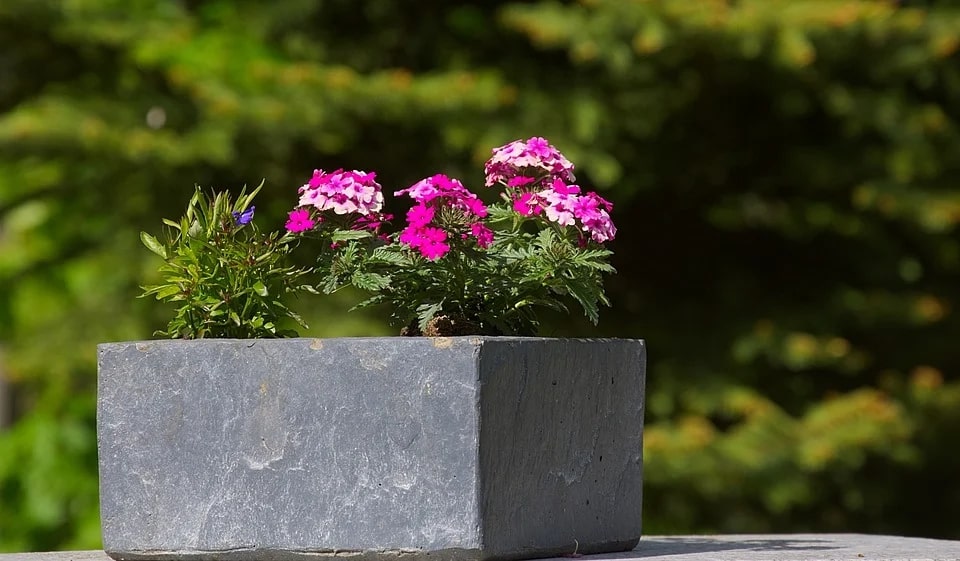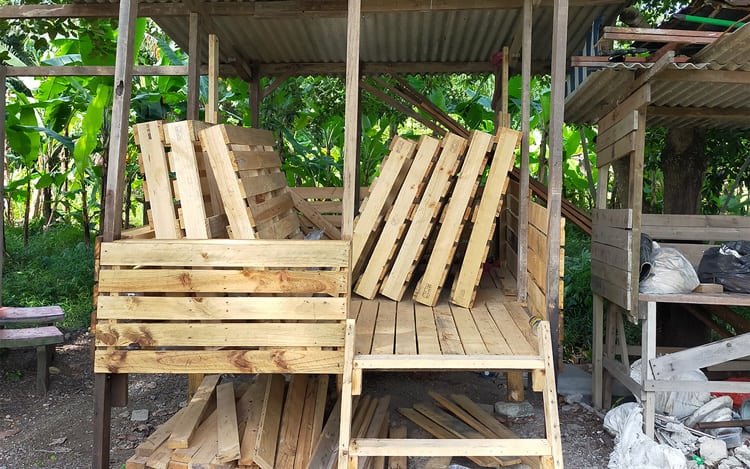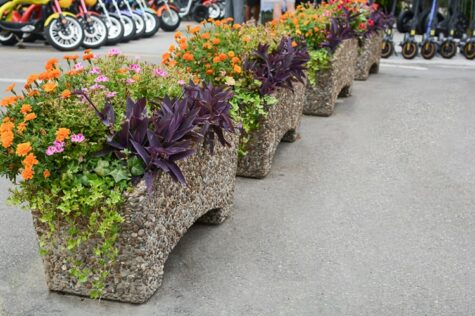Whether you want to create a new seating area in your garden or simply mask an exposed part of your property, a privacy screen planter is a space-efficient way to do it.
Privacy screen planters can add personality to any garden. They fill space beautifully and increase your privacy without sacrificing style, plus, you can grow several plants in addition to climbers.
Here’s how to build a privacy screen planter, one step at a time.

Image credit: @woodluck_product
How to make a planter box with privacy screen step by step
For this project, you can adapt the length of the wood pieces to your needs. Start on paper and then cut the wood, assemble the frame, add the cedar boards, install the lattice or pallet board, and add the finishing touches. Having someone to help you with this project will make everything easier.
Let’s take a closer look at the key steps involved:
Materials you’ll need
- 2×6 x 4 long pieces of wood cut to the desired length
- 2×6 x 2 side pieces
- 2×6 x 4 short side pieces
- 4x4s x 2 shorter pieces (centres)
- 4x4s x 10+ short pieces (floorboards)
- 1x6s cedar boards x 10 (or more, depending on the planter size)
- Wood lattice/pallet/wood boards for the privacy screen
- Feet
- Finials (optional)
- 2 ½ inch screws
- Short nails
- Wood glue
- Water-repellent stain
- Electric saw
- Jigsaw
- Electric screwdriver
- Staple gun
- Hammer
Step 1 – Cut the wood
You can make the privacy screen as big as you need it to be. Cut the lumber for the frame to the desired length. For a sturdy frame, you’ll need four 2×6 long pieces and six 2×6 shorter pieces for the sides. You’ll also need two 2×6 shorter pieces for extra support at the centre of the longer sides.
Important: Determine the height of the privacy screen. Based on this, you may also have to cut the two 4x4s that will support it.
Step 2 – Assemble the long sides of the frame
Place one of the shorter pieces of 2×6 board vertically at the centre of a long 2×6 board. Drill diagonal pilot holes in it. Drive screws through the diagonal holes and fix the short piece in place.
Turn it over and attach the other long 2×6 board to it. For this, drive holes through the other end of the shorter piece and into the long board. You should end up with a large, horizontal “H”.
Repeat the process for the other part of the frame. Don’t worry about the ends of the frame just yet. You’ll attach them to the 4x4s later.
Step 3 – Assemble the sides of the frame
Now it’s time to build the sides of the frame.
Attach two short 2×6 pieces to a side piece using one diagonal pilot hole and screw for each. This part of the frame should look like a big “C”.
Repeat the process for the other side.
Step 4 – Attach the frame to the privacy screen supports
Attach the two “C” sides to one of the longer, upturned “H” sides to create the front of the frame. Drive two or more screws where the wood meets.
Fix the 4x4s with screws to the ends of the other horizontal “H” to create the back of the frame.
Tip: It’s easier to do this with the 4x4s lying on the ground.
Next, you want to attach the back side of the frame to the front. For this, you’ll have to drive some more screws through the 4x4s so that they reach the ends of the “C” sides.
Step 5 – Add the floorboards
Add the floorboards, screwing each in place with two 2 ½ inch screws at both ends. Work this part with the frame and screen posts standing up.
Note: Depending on the size of the planter, you may have to use more than 10 floorboards.
Step 6 – Add the feet
So that the frame doesn’t sit directly on the ground, you can add 4 feet to the frame. Get someone to help you handle the frame. Fix the feet with screws.
Step 7 – Add the cedar boards
Now it’s time to make your privacy screen planter look nice.
Add the 1×6 cedar boards to the frame you’ve made. Start from the top so that the first board is flush with the top of the frame. Fix each board with two or more screws at both ends.
Work the front and back first and then the sides. Depending on the width you want for the planter, you could make two or three side boards from one long 1×6 cedar board.
Step 8 – Install the privacy screen
Whether you choose to use a wooden lattice, pallet, or wood boards, the process is the same.
Simply nail the privacy screen to the 4×4 posts. You may have to use a jigsaw to cut the lattice or pallet to the right size to fit the boards.
Tip: If you use wood boards to build a custom screen, you can reinforce the boards with a longer vertical board that runs behind the screen. Or you can use long boards that reach from one 4×4 post to the other.
Step 9 – Add the finishing touches
Glue the finials to the top of the 4x4s for a more finished look. If you use a pallet board or nail boards across the posts, finials may not be necessary.
Also optional is to add four horizontal boards to the top of the box. Cut them at a 45-degree angle so that they fit together well.
Step 10 – Stain the wood
You’re almost there, make sure you don’t skip this step.
Staining your new privacy screen planter will make it ready for outside weather. Use a water-repellent wood stain.

Credit: Shutterstock
Tip: Stain all of it, including the inside and the back, to make sure it won’t rot.
Step 11 – Line the planter box
Last but not least, prepare the box for the soil.
Line the inside of the box with landscape fabric. Staple it in place so you can fill the planter with soil without worrying that the fabric may shift under it.
Important: Make sure the fabric you use allows for water to drain from the bottom of the planter. If you’re not sure, make some holes in the fabric.
And with that, you’ve finished building your planter box with privacy screen.
Tip: You can put a climbing plant in the planter alongside other plants so that it will cover the lattice or pallet.
More on this: How to Waterproof A Wooden Planter Box
How to make a planter box privacy screen the easy way
You can save time building a planter box privacy screen by buying a lattice or using a pallet box. You can then simply attach it to the 4×4 posts at the back of the planter or attach it to a custom-sized wooden frame. Then simply fix this to the back of the planter with screws.
Building a privacy screen this way will save you time and money compared to assembling it from boards. The only exception is if you already have some spare wood boards. You can assemble these separately on a wooden frame, fixing them with a vertical board in the middle. Then simply add the screen to the planter.
How to build a screen planter box fast
Our step-by-step guide showed you how to build a stylish planter box with privacy screen. But if you already have some spare lumber and wooden boards, you can simplify the process.
You can build a simple planter box with 8 long boards, 8 shorter side boards, and four 4×4 lumber pieces.
Fix 4 of the long boards and 4 of the side boards to a piece of lumber at each end, screwing it in place with an electric screwdriver.
Repeat for the other side, and you’ll have a simple, bottomless, and legless planter box that you can put directly on the ground.
Line the box with landscape fabric and fix an upright pallet or lattice panel to the back of the box with screws. And with that, you’ve finished with the box and got rid of the boards, too.
DIY planter box with screen ideas
Planter boxes with screens don’t always have to be made of wood. You can play around with other materials, some of which are more resistant. Not all alternative materials look rustic, it’s true. But the end result doesn’t have to look bad.
Here are some interesting takes on the classic planter box with screen:
Brick and PVC pipe privacy screen planter box
If you don’t mind messing around with mortar, you can try building this brick planter box. Get enough bricks for the size you want the planter to be and cement them in place. For the privacy screen, you can use PVC pipes. You’ll need two longer and two shorter PVC pipes for the frame and larger pipe cuttings for the trellis. Glue them with waterproof glue and paint them any colour you want.
Artificial bamboo plants planter box screen
One of the easiest ways to create a privacy screen planter box is to stick tall artificial bamboo plants into an existing planter box. It may not provide as much privacy as a pallet planter, but it works. You’ll need to anchor the artificial shoots well and place the planter box in a sheltered position.

Credit: Pinterest
Wire mesh planter box privacy screen
You can also use wire mesh to create a privacy screen for your planter boxes. You’ll need patience to wait for the climbing plants to cover the mesh, but if you need several screens for multiple planter boxes, it can be a cost-effective solution. You can simply stretch the wire across two 4×4 wooden posts that you fix inside the planter box with clamps and screws.

Credit: Pinterest
The wrap up
A planter box with privacy screen can become a standout feature in your garden. More than its functional applications, it can look so good you’ll want to create a seating area near it.
Taking the time to build it well the first time will mean you can enjoy it for years to come. Follow our steps and tips and you can’t go wrong.

Save this pin for later






